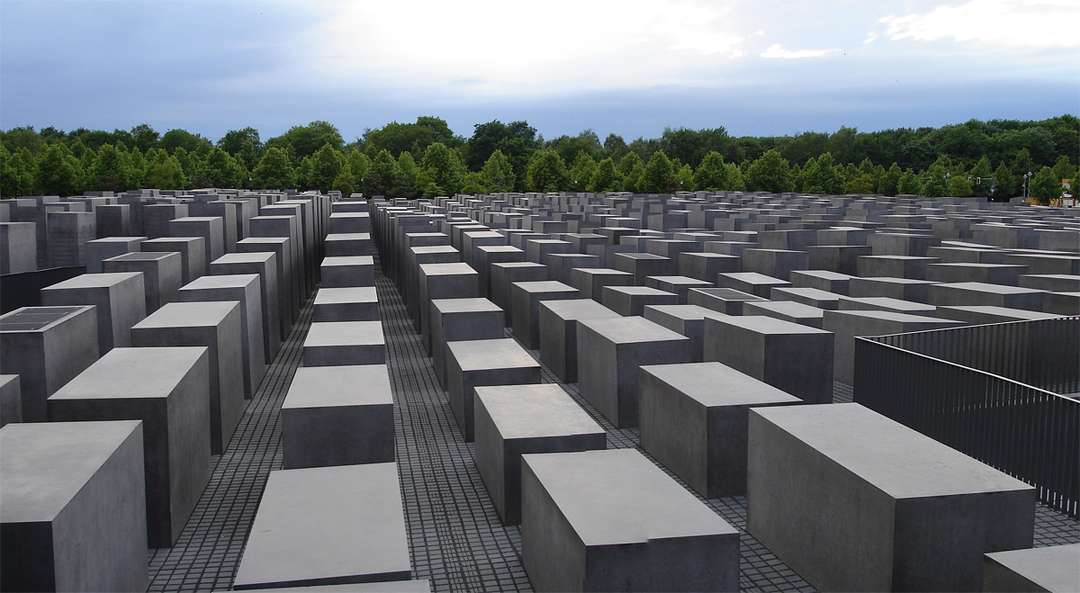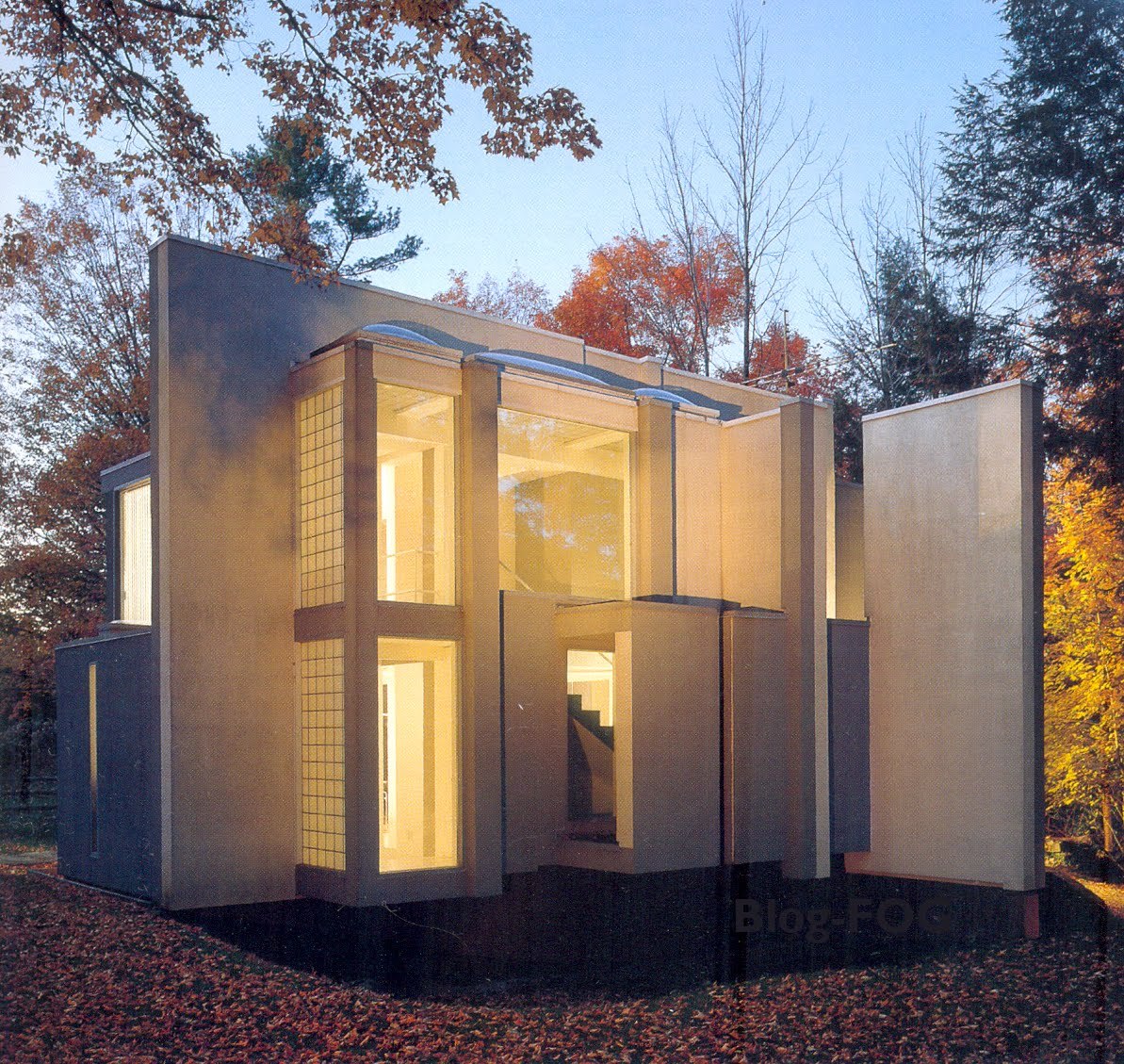 |
| Peter Eisenman: City of Culture of Galicia, Spain (under opbygning 2011) |
Jeg fortsætter lidt ud af sporet 'dekonstruktivistisk arkitektur' fra foregående indlæg.
Min unge arkitektstuderende har nemlig i en mail fremhævet amerikaneren Peter Eisenman som særlig bemærkelsesværdig blandt de arkitekter som forbindes med dekonstruktivismen som tænkningen bag koncepterne for deres bygninger.
Hvem er Peter Eisenman? Hvad tænker han, og hvad har han lavet?
Jeg kender ham først og fremmest fra det berømte og kontroversielle mindesmærke i Berlin for de millioner af jøder der døde i nazisternes koncentrationslejre:
 |
| Peter Eismann: Memorial to the Murdered Jews of Europe, Berlin |
Ingen tvivl om det! Det gjorde indtryk da jeg så det i Berlin for 3-4 år siden:
En kæmpe plads med flere tusinde forskellige, men alle rektangulære 'kister' af beton, på engelsk benævnt 'stelea'.
Provokerende fremmedgørende. Og fascinerende.
I tal:
The stelae are 2.38 m (7 ft 10 in) long, 0.95 m (3 ft 1 in) wide and vary in height from 0.2 to 4.7 m (7.9 in to 15 ft 5.0 in).[2] They are organized in rows, 54 of them going north–south, and 87 heading east–west at right angles but set slightly askew.
Mindesmærket er dog ikke et helt typisk eksempel på den arkitekturretning som forbindes med dekonstruktivismen.
Man plejer nemlig at identificere dekonstruktivistisk arkitektur med en protest - et oprør - mod de firkantede former og rette vinkler der er altdominerende i den traditionelle arkitektur.
Det er en arkitektur-retning der er udtryksmæssigt i opposition - en arkitektur der dyrker "non-rectilinear shapes", som Wikipedia kalder det. Og den giver egnetlig først betydning og kan 'aflæses' i kraft af den arkitektur den opponerer imod.
Og selv om mindesmærket i Berlin godt nok er 'rectilneært' så det basker, så giver det jo god mening som et oprør mode traditionelle mindesmærkers opulent figurative stil.
Man føler sig berørt, men ikke velkommen, oplever jeg.
Når man læser hvad der er skrevet om Peter Eisenmann, så bliver man klar over at hans betydning nok er mere teoretisk end i mængden af realiserede byggerier inden for dekonstruktiv arkitektur.
Og googler man hans navn og går til billedoversigten, så er der flere modeller end fotos af faktiske bygningsværker.
Hans tætte forbindelse med dekonstruktivismens filosofiske ophavsmand, franskmanden Derrida, fremhæves mange steder.
Her fortæller Wikipedia om oprindelseshistorien:
Deconstructivism came to public notice with the 1982 Parc de la Villette architectural design competition (especially the entry from Jacques Derrida and Peter Eisenman[1] and Bernard Tschumi's winning entry), the Museum of Modern Art’s 1988 Deconstructivist Architecture exhibition in New York, organized by Philip Johnson and Mark Wigley, and the 1989 opening of the Wexner Center for the Arts in Columbus, designed by Peter Eisenman.The New York exhibition featured works by Frank Gehry, Daniel Libeskind, Rem Koolhaas, Peter Eisenman, Zaha Hadid, Coop Himmelb(l)au, and Bernard Tschumi.Since the exhibition, some architects associated with Deconstructivism have distanced themselves from it. Nonetheless, the term has stuck and has come to embrace a general trend within contemporary architecture.
 |
| Peter Eisman: Wexner Center for Arts, in Columbus, 1983... |
Derridas teori om betydningen af 'dekonstruktion' var i sit udgangspunkt en semiotisk teori som kunne fundere en særlig kritisk form for tekstanalyse af litteratur. ('semiotik' = læren om tegnenes liv i samfundet).
Wikipedia:
Deconstruction generally tries to demonstrate that any text is not a discrete whole but contains several irreconcilable and contradictory meanings; that any text therefore has more than one interpretation; that the text itself links these interpretations inextricably; that the incompatibility of these interpretations is irreducible; and thus that an interpretative reading cannot go beyond a certain point.
Det er ikke helt indlysende hvordan denne filosofisk-lingvistiske-teoribygning lader sig transformere ind i en tænkning om arkitektur som skabes af stål, glas og beton.
Men denne 'konceptuelle blending' af beton og lingvistisk analyse leverer altså som resultat en slagkraftig ide om at 'arkitektur er et sprog' - og kan aflæses som et sprog - med indbyggede modsigelser.
Og det kom der byggerier ud af som gør indtryk og bliver ikoner.
Senere i Wikipedai-artiklen får vi en mere detaljeret beskrivelse af hvad Derrida har betydet for Peter Eisenman, og hvordan flere af de dekonstruktive arkitekter ser deres bygningsværker som en form for sprog eller skrift:
The main channel from deconstructivist philosophy to architectural theory was through the philosopher Jacques Derrida's influence with Peter Eisenman. Eisenman drew some philosophical bases from the literary movement Deconstruction, and collaborated directly with Derrida on projects including an entry for the Parc de la Villette competition, documented in Chora l Works.Both Derrida and Eisenman, as well as Daniel Libeskind[5] were concerned with the "metaphysics of presence," and this is the main subject of deconstructivist philosophy in architecture theory. The presupposition is that architecture is a language capable of communicating meaning and of receiving treatments by methods of linguistic philosophy.[6]
Centralt i Eisenmans arkitekturfilosofi står den dialektiske modsætning mellem nærvær ("precense") og fravær ("absence") - massiv ("solid") og ugyldig ("void"):
The dialectic of presence and absence, or solid and void occurs in much of Eisenman's projects, both built and unbuilt. Both Derrida and Eisenman believe that the locus, or place of presence, is architecture, and the same dialectic of presence and absence is found in construction and deconstructivism.[7]
Vi springer lige til en af de andre guruer inden for traditionen: Frank Gehry.
En af de tidligste eksempler på konsekvent brug af 'non-recitlinære' (='skæve') former er Frank Gehrys eget hjem i Snata Monica, Californien, som er en ombygning af et oprindeligt traditionelt hus fra 1920.
 |
| Frank Gehrys eget hus fra 1978 (1920) |
Wikipedia-artiklen fortæller om baggrunden for dette hus´ arkitektoniske udtryk set gennem Derridas filosofiske briller:
According to Derrida, readings of texts are best carried out when working with classical narrative structures. Any architectural deconstructivism requires the existence of a particular archetypal construction, a strongly-established conventional expectation to play flexibly against.[8]The design of Frank Gehry’s own Santa Monica residence, (from 1978), has been cited as a prototypical deconstructivist building. His starting point was a prototypical suburban house embodied with a typical set of intended social meanings. Gehry altered its massing, spatial envelopes, planes and other expectations in a playful subversion, an act of "de"construction"[9]
Derridas begreber om spor ("trace") og udviskning/sletning ("erasure") er en vigtig del af filosofien bag den destruktivistiske arkitektur.
Pointen er at når man (magthavere, samfundet, autoriteter) prøver at udviske eller slette noget fra historien, så vil der altid være spor tilbage.
Og de spor af det der er slettet, er det arkitektens konceptuelle opgave at bygge på gennem udtrykket i sine bygninger:
In addition to Derrida's concepts of the metaphysics of presence and deconstructivism, his notions of trace and erasure, embodied in his philosophy of writing and arche-writing[10] found their way into deconstructivist memorials.Daniel Libeskind envisioned many of his early projects as a form of writing or discourse on writing and often works with a form of concrete poetry. He made architectural sculptures out of books and often coated the models in texts, openly making his architecture refer to writing.The notions of trace and erasure were taken up by Libeskind in essays and in his project for the Jewish Museum Berlin. The museum is conceived as a trace of the erasure of the Holocaust, intended to make its subject legible and poignant. Memorials such as Maya Lin's Vietnam Veterans Memorial and Peter Eisenman's Memorial to the Murdered Jews of Europe are also said to reflect themes of trace and erasure.
Peter Weisenman har lavet mange modeller af dekonstruktive bygningsværker, men kun relativt få er blevet realiseret.
Her nogle af dem han har fået realiseret:
 |
| Peter Eisnman: Aronoff Center for Design and Art, Cincinnati, OH. 1988-1999 |
 |
| Busshelter in Aachen, by Peter Eisenman architect in 1996 |
En kilde gør opmærksom på at Eisenman er inspireret af den japanske papir-folde-kunst-tradition origami:
 |
| Japansk origami-svane |
 |
| Peter Eisenman: Model, 'The Max Reinhardt House, Berlin1992 |
 |
| Peter Eisenman: Model: Til konkurrence om en kirke i Rom, 1996 |
Et af de (delvist) realiserede projekter er dette kulturcenter-kompleks i Santiago de Compostella i Spanien hvor der mere er tale om bløde former end om skarpe origami-trekanter:
 |
| Peter Eisenman: City of Culture of Galicia, Spain (luftfoto) |
 |
| Peter Eisenman: City of Culture of Galicia, Spain (set i øjenhøjde) |
 |
| Nærbilleder fra City of Culture-komplekset |
 |
| Konkurrencemodel til City of Culture-komplekset, 1999 |
Peter Eisenman har fået stor indflydelse som arkitektonisk filosof, teoretiker og underviser, men er også samtidig berygtet for at hans bygninger i praksis er dårligt funderet når det gælder brugen af materialer.
De overskrider også budgetterne - og kræver omkostningstunge renoveringer efter få år, går kritikken på.
Projektet City of Culture of Galicia er ikke gjort færdigt efter projektetplanen, man har stoppet byggeriet af de to sidste sektioner 2013.
Wikipedia:
The City of Culture of Galicia (Galician: Cidade da Cultura de Galicia or simply Cidade da Cultura) is a complex of cultural buildings in Santiago de Compostela, A Coruña, Galicia,Spain, designed by a group of architects led by Peter Eisenman.Construction is challenging and expensive as the design of the buildings involves high degree contours, meant to make the buildings look like rolling hills.Nearly every window of the thousands that are part of the external façade has its own custom shape.[1]In 2013 it was announced that after more than a decade, construction of the project would be halted. The International Art Center and Music and Scenic Arts Center will not be built.[2](...)The project has more than doubled its original budget and has not attracted significant numbers of visitors (becoming a white elephant for subsequent governments and taxpayers).[3] Construction of the final two planned buildings was stopped in 2012 and terminated definitively in March 2013 due to the high cost overruns.[4]
I Wikipedias portrætartikel om Peter Eisenman får han også med krabasken: menneskefjendsk og dårlig byggeri i praksis.
His focus on "liberating" architectural form was notable from an academic and theoretical standpoint but resulted in structures that were both badly built and hostile to users.The Wexner Center, hotly anticipated as the first major public deconstructivist building, has required extensive and expensive retrofitting because of elementary design flaws (such as incompetent material specifications, and fine art exhibition space exposed to direct sunlight).It was frequently repeated that the Wexner's colliding planes tended to make its users disoriented to the point of physical nausea; in 1997 researcher Michael Pollan tracked the source of this rumor back to Eisenman himself. In the words of Andrew Ballantyne, "By some scale of values he was actually enhancing the reputation of his building by letting it be known that it was hostile to humanity."
Så tilsyneladende har Weisenman selv ønsket "dårlig omtale".
Det har han også fået når det gælder et meget tidligt byggeri: House VI fra midten af 70´erne, et projekt som endte med en alvorlig økonomisk øretæve for 'klienterne', ægteparret Frank :
Peter Eisenman: Hous VI, 1970 His House VI, designed for clients Richard and Suzanne Frank in the mid 1970s, confounds expectations of structure and function. Suzanne Frank was initially sympathetic and patient with Eisenman's theories and demands. But after years of fixes to the badly specified and misbegotten House VI (which had first broken the Franks' budget then consumed their life savings), Suzanne Frank was prompted to strike back with Peter Eisenman's House VI: The Client's Response, in which she admitted both the problems of the building, as much as its virtues.
Jeg har fundet en interessant artikel hvor Peter Eisenmans arkitekturtænkning konfronteres med en anden international kendt arkitekts ideologi, Peter Zumthors - under rubrikken: "Peter Versus Peter: Eisenman And Zumthor's Theoretical Throwdown".
I artiklens terminologi er der tale om et modsætningsforhold mellem konceptuel arkitektur og fænomenologisk arkitektur. Og de to arkitekter med samme fornavn som mig, udveksler verbale slagserier:
In architecture, the conceptual model sees architecture as a practice to be undertaken for its own sake whether as drawings or built work, whereas many phenomenologists, Zumthor included, see buildings as things that interact with and participate in human sensory experience.In the aforementioned interview, Eisenman states, “If there is a debate in architecture today, the lasting debate is between architecture as a conceptual, cultural, and intellectual enterprise and architecture as a phenomenological enterprise–that is, the experience of the subject in architecture, the experience of materiality, of light, of color, of space, and etc. I have always been on the side opposed to phenomenology.”Zumthor, for his part, is equally dismissive of conceptual architecture. “Architecture is something for living, not a language. My mother wants a house for living, not a language. It isn’t possible to live in a language,” he writes in an interview with Marco Masetti. “In Italy, but also in the United States, there are academic architects who remain out of the market. Professors that maybe haven’t built more than a garage, but they talk very well.”
Læse mere om konfrontationen mellem de to arkitektur-syn her:
Og her fotos af en række af Peter Zumthors byggerier, som godt nok er i en anden arkitektonisk boldgade end Weisenmans:
 |
| Kolumba, erzbischöfliches Diözesanmuseum, Köln, 2007 |
 |
| Bregenz kunsthaus, 2002 |
 |
| Therme Vals facade, Vals, Graubünden, Switzerland, 2005 |
 |
| St Benedict Chapel, Switzerland, 1988 |
 |
| Wachendorf-Feldkapelle-Bruder-Klaus, 2007 |
Peter Zumtor er i hvert fald ikke bange for rette vinkler i sine byggerier.

Ingen kommentarer:
Send en kommentar